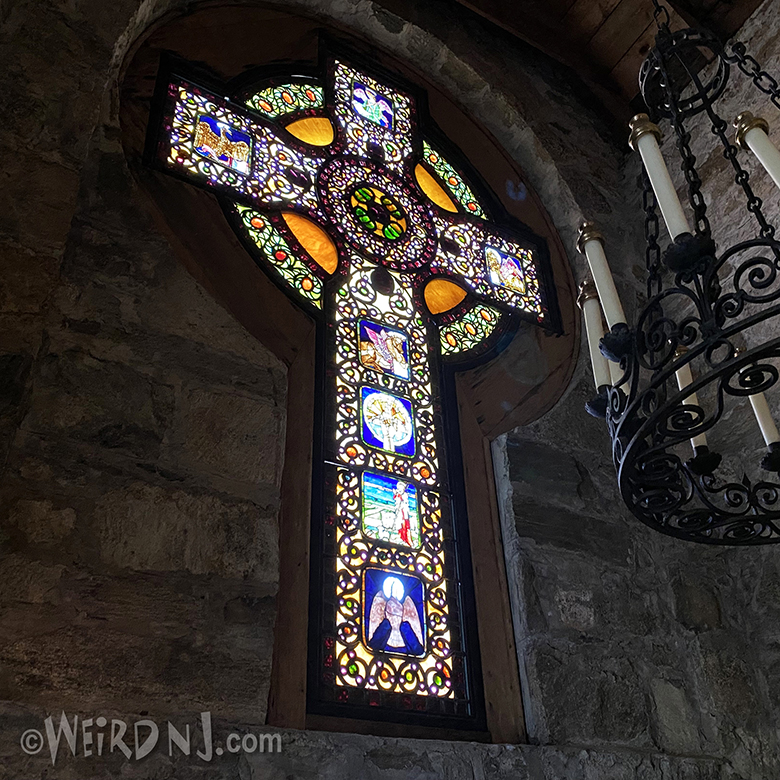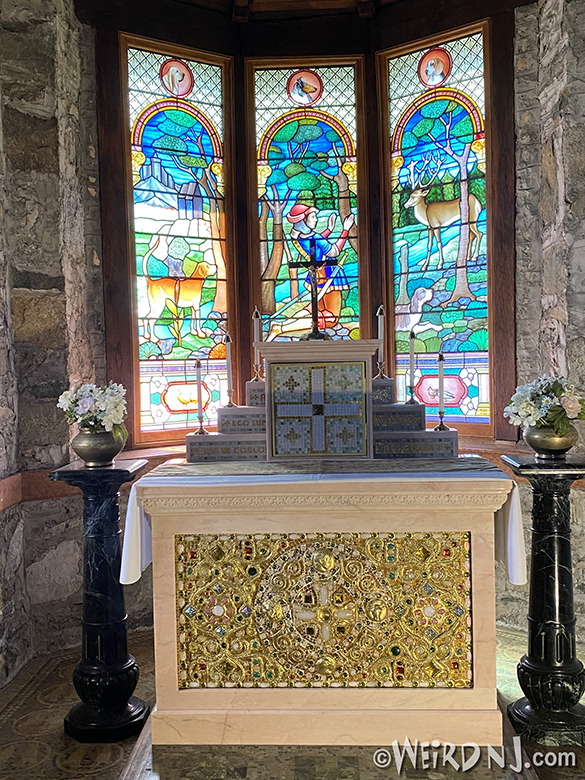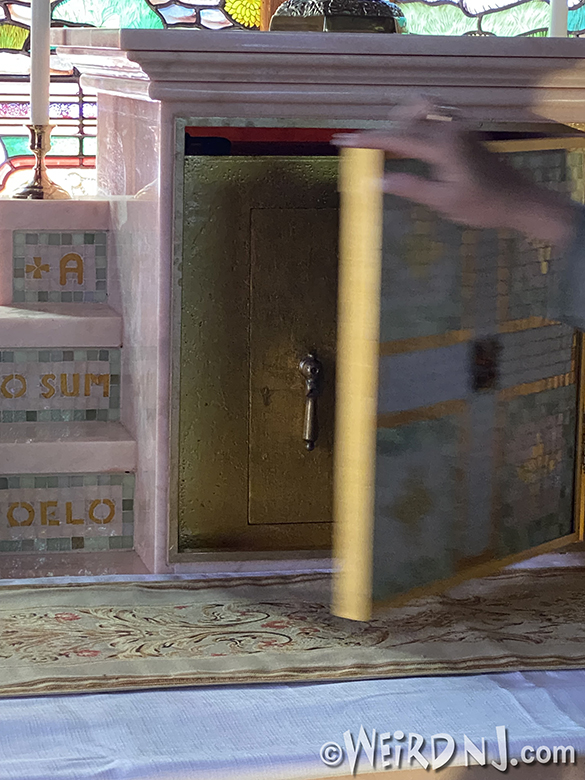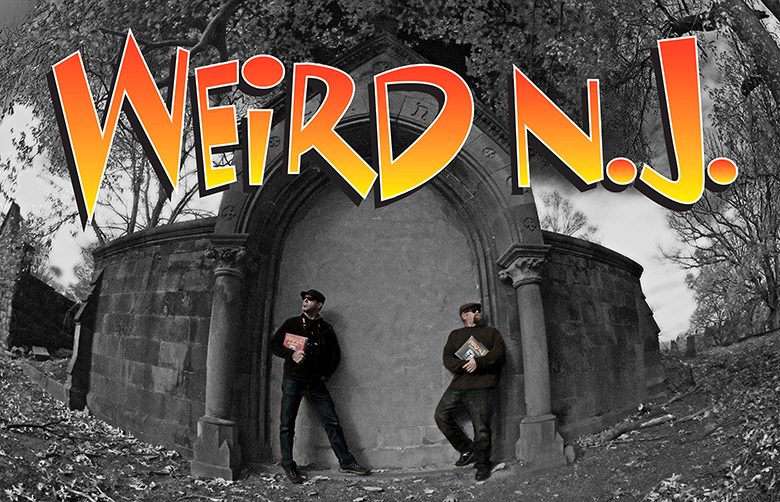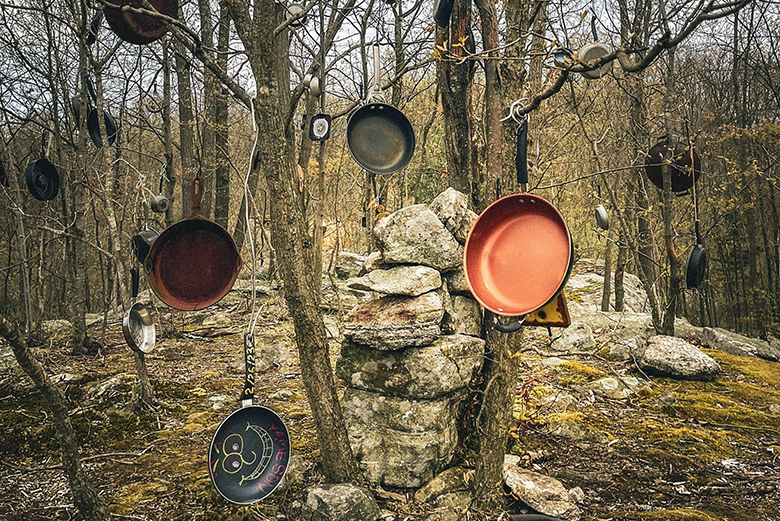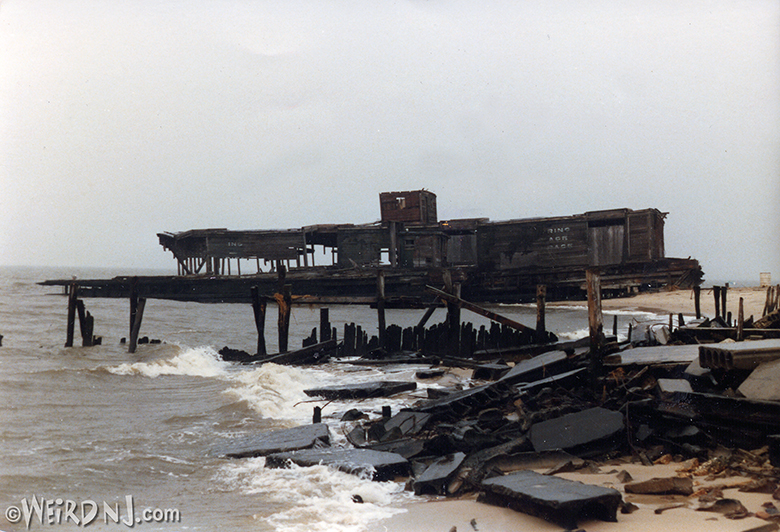The Resurrection of St. Hubert’s Chapel
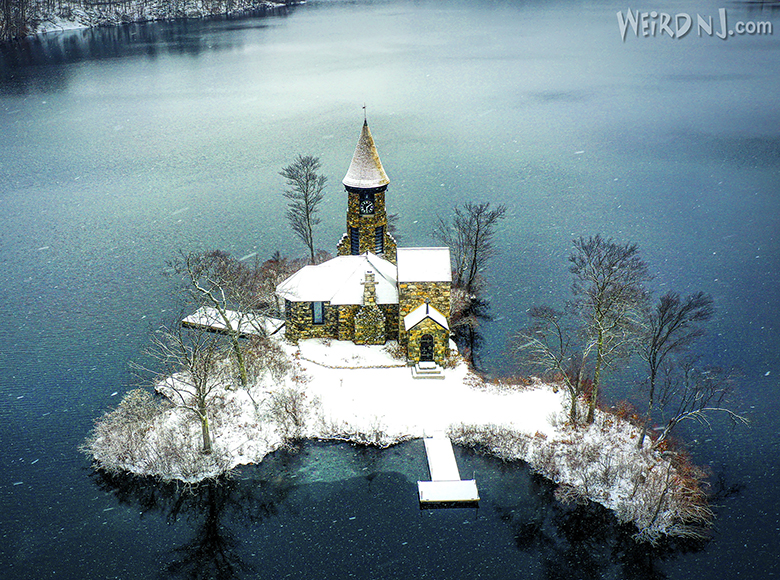
Photo by Mike Innella/North Jersey Drone Shots
The Resurrection of St. Hubert’s Chapel
By William Angus
It was September 11th, 2021, a pleasantly warm day. I was standing on the shore of a beautiful lake in Smoke Rise (part of Kinnelon). It was after Labor Day so the beach was nearly empty but several people marched past me, their arms full of fishing gear. A strangely silent boat cruised by and a cute dog peered at me from the bow. It was pleasantly quiet except for the occasional voices of some children on the beach and birds chirping in the nearby trees. I was absent-mindedly scrolling social media and reading reports on 9/11 ceremonies in NYC when Hillary walked up to me. After a few minutes of small talk, she escorted me and my girlfriend to a dock where we boarded a small boat. We quickly shoved off and our captain, Bob Hayden, began the short 3-minute ride to a tiny island in the middle of the lake. He explained that the community only permits electric motors on boats that operate in the lake in order to reduce the noise pollution. I could see the steeple of St. Hubert’s Chapel and as we circled around it to the dock, I saw a large stained glass cross which reflected beautifully in the early afternoon sun.
I first learned of the chapel nearly 20 years ago from Weird NJ issue #20. I had tried unsuccessfully to visit Smoke Rise in the late 2000s. I wasn’t fool enough to think I’d get to the island, but I had hoped to maybe see it from shore. Unfortunately, Smoke Rise is a gated community and they value their privacy greater than a dragon values treasure. I learned a few years ago that the preservation group that is fixing the chapel up had been doing tours each summer. They didn’t do them in 2020 because the pandemic and 2021 looked iffy, but finally after years of waiting, there it was in front of us. We were greeted by Tom Kline and his wife, who gave us a brief but very thorough tour. So what is St Hubert’s chapel and how come it’s on a tiny island in the middle of a gated community? The story begins nearly 140 years ago with Francis Kinney, a 19th-century industrialist who founded Kinney Brothers Tobacco Company. Kinney owned 5,000 acres of land in the middle of Morris County and built a 20,000-square foot “summer cottage” on the shores of this small lake to use as a hunting and fishing retreat. Much like medieval lords in Europe, he had armed men patrol the property to keep others from illegally hunting on their grounds. His wife Mary was a devout Catholic but was also rather ill. The trip to the nearest church was seven miles by horse carriage and proved quite difficult for her to endure. Being a rich man who loved his wife, he had a church built for her and every Sunday a priest and altar boy would conduct a Mass for the Kinney family.
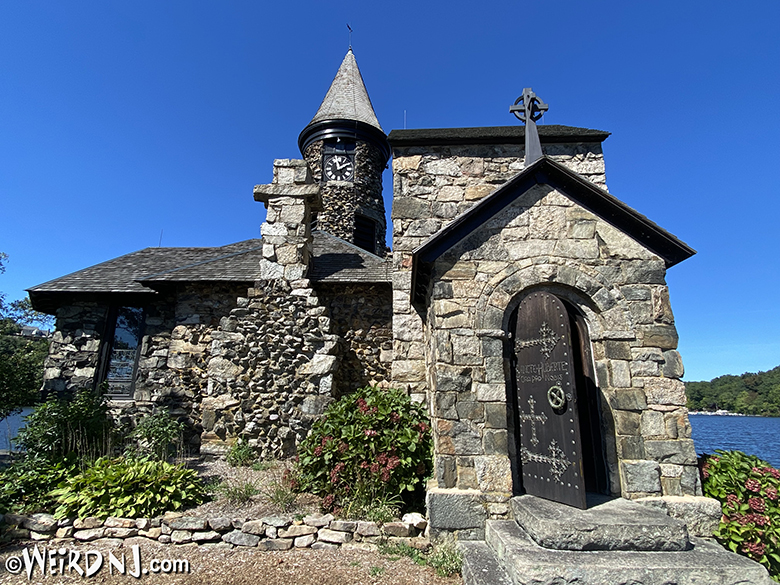
Plans for St. Hubert’s Church began in 1886 and three years later it was ready for its sole parishioners. The chapel was designed (without thought to cost) to replicate a church from medieval times, from the part of Europe where the original St. Hubert lived back in the 700’s. The legend of St. Hubert says that while out on a hunt, Hubert came across a large white stag with a crucifix lodged in its immense antlers. The stag commanded him to seek spiritual guidance from Bishop Lambert and this moment changed his life. He converted to Catholicism and when the Bishop died, he succeeded him. He actively sought to root out pagan worship and spread the reach of Christianity throughout what is now Belgium. In 727 he was proclaimed a Saint – the patron saint of huntsmen.
Kinney contracted with Tiffany’s (yes, that Tiffany’s) and they conducted extensive research on St. Hubert as well as what churches of his day looked like. They created a giant ten foot tall stained glass cross that weighed nearly 1,000 pounds, a bronze tablet commemorating St. Hubert, a mosaic tile floor consisting of 300,000 hand laid pieces of marble, a giant marble altar, a bronze statue of the Madonna and Child and a large bell tower, housing a clock as well as three large bells. Powered by weights weighing half a ton, the clock chimed on the quarter hour for 50 years.
The chapel was expanded in 1904 but by then Mary Kinney had passed away and Francis Kinney died four years later. In 1924 his son Warren sold his share of the estate to his brother Morris, and when he died in 1945, the property passed to a lifelong friend, John Alden Talbot. Almost immediately Talbot began organizing the development of the Smoke Rise community and by 1951 seventy-five families owned homes in the development. These families used the chapel for religious services until 1951. By then the number of people wanting to use it exceeded its capacity and services were moved to the Village Inn. That was its house of worship for five years until 1956 when the new Community Church of Smoke Rise opened its doors.
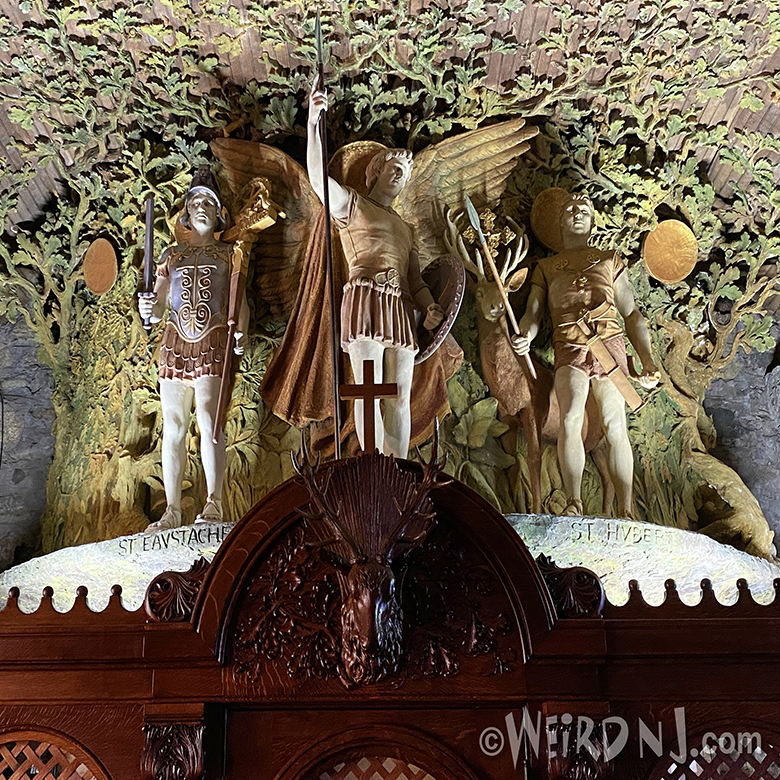
A year later several local teens took a rowboat to the island, broke in and essentially destroyed the chapel. Although the building still stood, most of what was inside was destroyed. Whatever was not destroyed would be destroyed by vandalism and theft over the next few years. The majestic chapel was left alone, forgotten for over a decade. Although efforts were made in the late 60s to restore the chapel, it would be almost 40 years before anything substantial was achieved. Progress was finally made when the deed to the island and chapel were turned over the community in 1990. The recently established 501c called the “Kinnelon Heritage Conservation Society” was able to secure funding grants with the intent to preserve historic sites throughout the town. In 1991 the St. Hubert’s Chapel Conservation Committee was established and is responsible for maintaining the property and making improvements and renovations.
In the 30 years since, a lot of progress has been made. In 2003 the Tiffany cross was restored, the marble altar was restored in 2007 and many of the original pews were reconditioned. The oak ceiling has been replaced and the St. Hubert stained glass windows were replaced in 2013. In 2015 all the remaining stained glass windows were recreated, and for the first time since 1957 all the windows were as they once were.
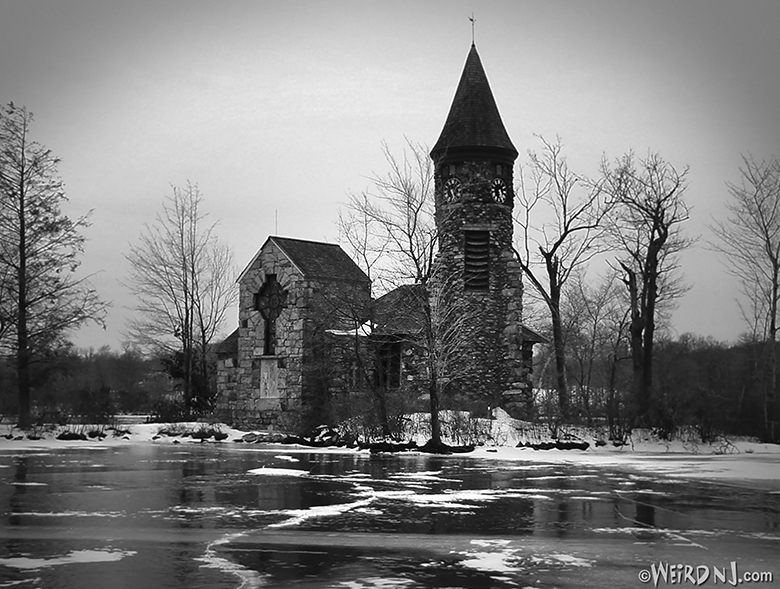
Revisiting the Island Chapel
By Mark Moran
The first time I set out to visit St. Hubert’s Chapel was more than twenty years ago. I’d heard about this old chapel on an island and had to see it for myself. The problem was that it was located within the confines of a private gated community of which I was not a member. But I wasn’t going to let a small detail like that dissuade me.
Knowing I had no chance of gaining access through the checkpoints at the gates of the community, I determined to attempt entry through other, less legal channels. I decided to go on foot during a freezing cold day in January of 2003. I parked my car at the end of the nearest public road to Smoke Rise that I could find and walked into the snow-covered forest. I figured this would be the perfect time to visit the chapel because I could just walk across the frozen lake on the ice and I wouldn’t need a boat.
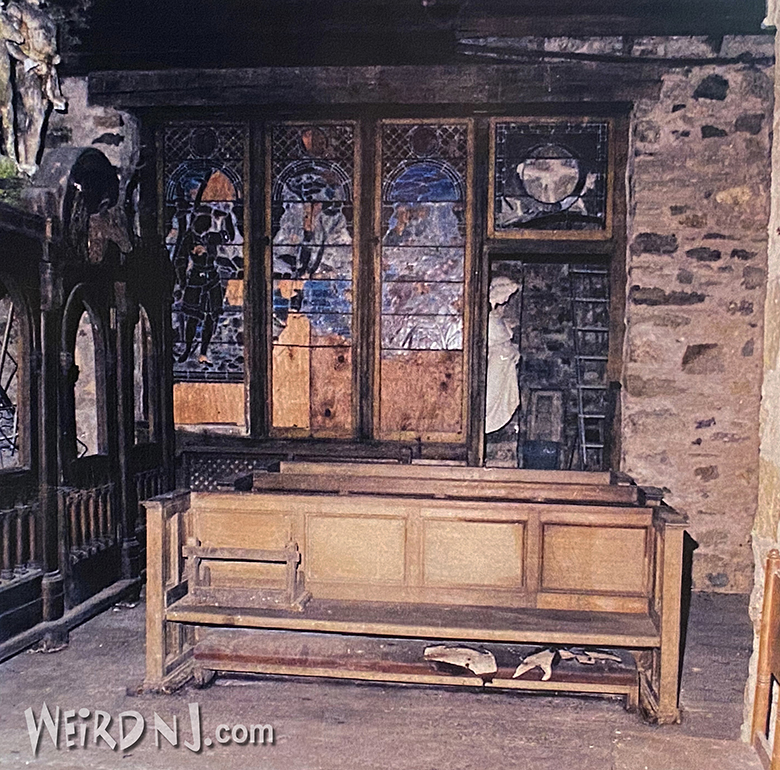 I hiked over the snowy mountain and soon came to a fence which marked the perimeter of community. This is where my heart sank, for although I knew that I would be trespassing if I ventured in, I hadn’t foresee having to jump over any barriers to do so. I began to walk along the fence in hopes of finding some small breech that might allow me access, without making me feel too much like a criminal. Lo and behold, Mother Nature, who recognizes no man-made borders, had provided me with a safe passage. She had laid low the boundary that separated me, the curious, from them, the cloistered, by dropping a huge dead tree directly across the fence. The ancient trunk actually seemed to be inviting me to cross over it to the other side. I felt it would have been downright impolite to refuse.
I hiked over the snowy mountain and soon came to a fence which marked the perimeter of community. This is where my heart sank, for although I knew that I would be trespassing if I ventured in, I hadn’t foresee having to jump over any barriers to do so. I began to walk along the fence in hopes of finding some small breech that might allow me access, without making me feel too much like a criminal. Lo and behold, Mother Nature, who recognizes no man-made borders, had provided me with a safe passage. She had laid low the boundary that separated me, the curious, from them, the cloistered, by dropping a huge dead tree directly across the fence. The ancient trunk actually seemed to be inviting me to cross over it to the other side. I felt it would have been downright impolite to refuse.
I knew as I continued on my journey that I was breaking the law, even though I intended no malicious acts or damage of any property. For this reason, the article I would subsequently write for issue 20 of Weird NJ was published anonymously. When I emerged from the woods onto the winding hilly streets of Smoke Rise I felt as if I was a spy who had just infiltrated the enemy’s lines. I walked quickly and deliberately through the tangled, meandering roads, sure that a security vehicle of some sort would pull up alongside of me at any moment and whisk me away for questioning, if not torture.
I avoided making eye contact with any of the passing motorists as I continued toward the lake. When I reached its banks, I gazed out over the frozen wasteland and was awestruck by what I saw. About 300 yards across the desolate wind-swept ice lay a small island. Rising up from its rocky shore was the dark spire of an old stone chapel. It looked like something you might see in a Scandinavian fjord.
For a moment I almost forgot my life-long fear of crashing through thin ice and sinking to a watery grave. That fear soon came rushing back over me though, as I bounded out onto the frozen surface and heard the low groaning “whoop” sounds of the ice sheets expanding and contracting beneath my feet. They emanated from far off then traveled toward me and rushing between my legs, then echoed through the valley. I stood motionless for a moment and assessed the situation. The ice was clear and dark, with drifting snow on top. I could see that it was at least eight to ten inches thick. In the distance I could make out the only other person in sight – an ice fisherman who a was furiously boring a hole into the ice with a gas-powered auger. This made me feel a little more secure, and I ventured forth, tentatively.
When I finally reached the island and placed my foot on its rocky shore I was relieved and excited. The chapel that rose up before me was a site to behold. Though derelict, it was still in good condition, most likely thanks to its location within the confines of such an exclusive community. There were no fences around it and no signs to warn off trespassers. I
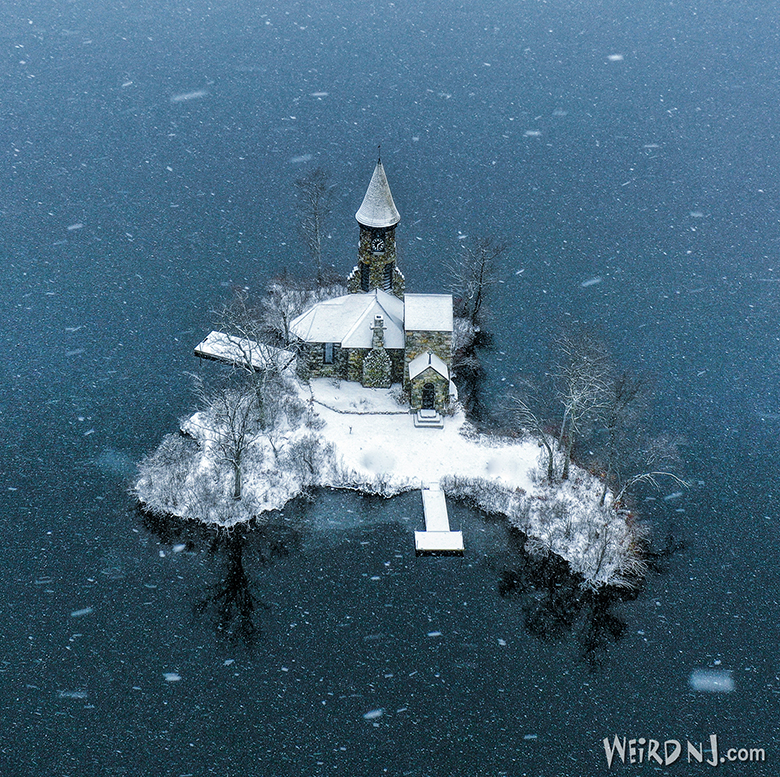
couldn’t help but think that the place probably wouldn’t stand a chance against marauding vandals if it were located someplace more accessible to the public.
The chapel was severely vandalized by a group of teenagers who had broken into it one night in 1957. They trashed the place, smashing all the windows and leaving it open to the elements. Without electricity or heating the chapel began to deteriorate rapidly and soon became infested with pigeons. Eventually the pigeon droppings became knee deep, completely obscuring the intricate mosaic floor.
Many of the stained-glass windows were still broken when I first visited, but the ones that remained were exquisite. There was a tall bell tower that had a large clock face on each of its four sides. All of the clocks were stopped at the same time – 5:25. The legend that I’d heard was that the clocks all stopped at the moment when Mrs. Kinney, who the chapel was built for, died.
I wondered about the people who had once worshiped there and about the lives they might have led. I didn’t linger for very long on the island though, just long enough to take a few pictures. My quiet revery became increasingly permeated by the eerie feeling that I was being watched, though I could not imagine who might have seen me out there all alone on that bleak winter’s day. As the light began to fade behind the mountains to the west and the sky turned a steely grey hue, I decided it was time for me to take my leave of that solitary place and head home to a warm fire and a hot drink.
I was happy to be allowed to visit St. Hubert’s Chapel once again, this time on a legally sanctioned excursion by way of an electric motorboat. It was a lovely fall day in 2021, and it was a very encouraging to see how much hard work the dedicated volunteers have put into restoring this one-of-a-kind landmark. Their labor has really paid off. The ransacked ruin that I’d witnessed nearly twenty years earlier had been meticulously renovated, both inside and out, to its original grandeur. It was an immaculate resurrection. Even the clock faces atop of the old bell tower are keeping accurate time again, and the bells, whose toll had fallen silent for so many years, now ring out across the water once more.
There’s a steel safe located behind a small door in the altar. Years after it had gone missing, it, along with other stolen artifacts from the chapel, such as the chandelier, crosses and candlesticks, would later be found at the bottom of the lake by fishermen and retrieved by divers.
 The preceding article is an excerpt from issue #58 of Weird NJ magazine, “Your Travel Guide to New Jersey’s Local Legends and Best Kept Secrets,” which is available on newsstands throughout the state and on the web at www.WeirdNJ.com. All contents ©Weird NJ and may not be reproduced by any means without permission.
The preceding article is an excerpt from issue #58 of Weird NJ magazine, “Your Travel Guide to New Jersey’s Local Legends and Best Kept Secrets,” which is available on newsstands throughout the state and on the web at www.WeirdNJ.com. All contents ©Weird NJ and may not be reproduced by any means without permission.
Visit our SHOP for all of your Weird NJ needs: Magazines, Books, Posters, Shirts, Patches, Stickers, Magnets, Air Fresheners. Show the world your Jersey pride some of our Jersey-centric goodies!
Retro Weird Wear Never Goes Out of Style…or Out of Stock!
Now you can have all of your favorite designs from the past on all kinds of cool new Weird Wear: Men’s Wear, Women’s Wear, Kids, Tee Shirts, Sweatshirts, Long Sleeve Tees, Hoodies, Tanks Tops, Tie Dyes, Hats, and accessories like Mugs, Backpacks, Stickers, Buttons and more! All are available in all sizes and a variety of colors.
Represent Jersey!

